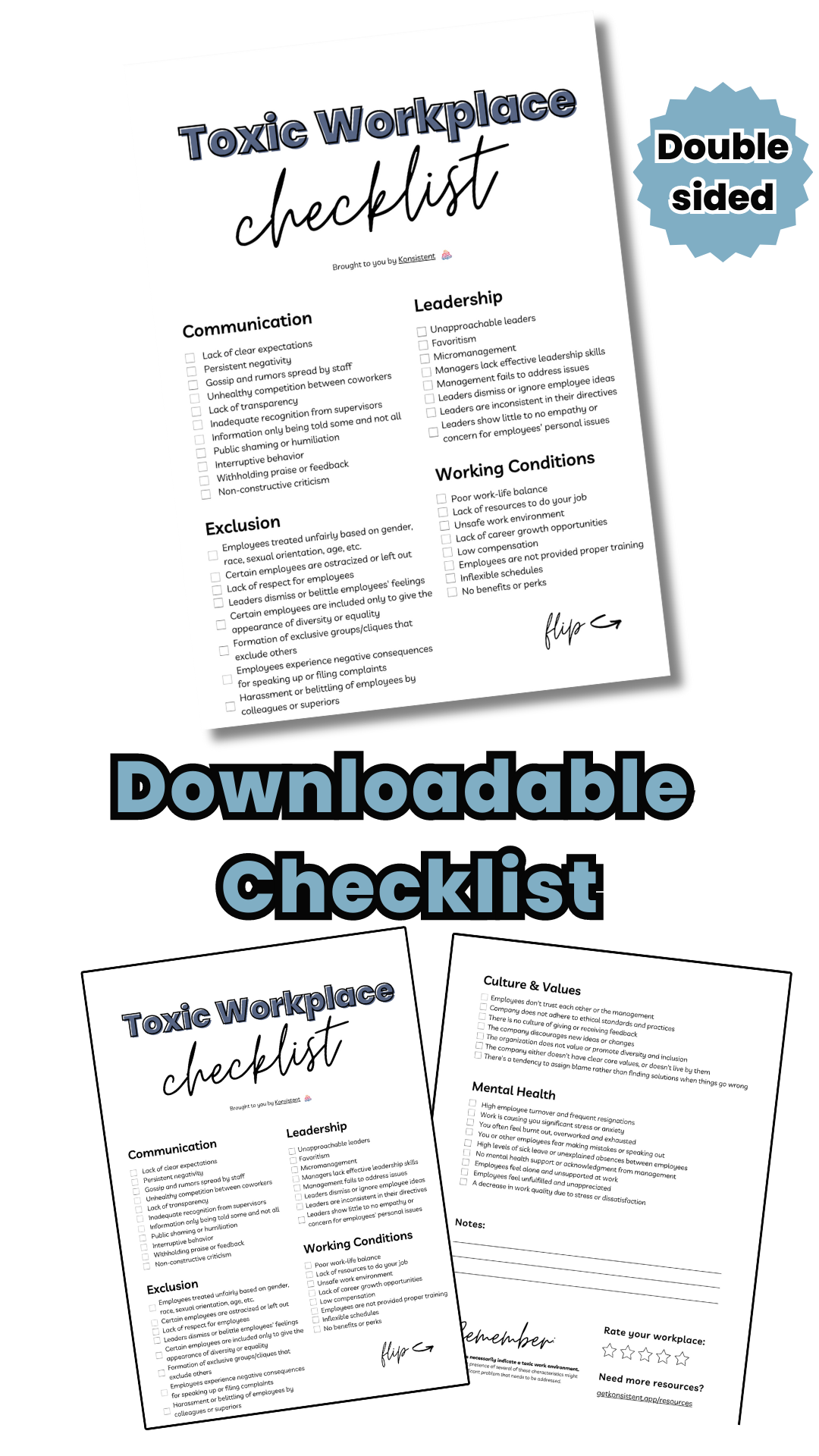15 Clear Signs of A Toxic Workplace: Checklist
12 May 2023 | 5 mins read
- Employee resources
- HR resources

Workplace culture plays a pivotal role in the success of any organization. In fact, research from Harvard Business School suggests that a positive environment significantly impacts productivity, job satisfaction, and employee retention.
Yet, not all workplaces foster the health and happiness of their employees. This article is here to help you recognize and rectify that.
We’ll be talking about toxic workplaces – what they look like, why they’re harmful, and how to turn things around. In the process, we will also introduce you to an innovative tool, Konsistent’s AI language detection app, that aids in creating a safer, more inclusive workspace.
Are you feeling stressed, unvalued, or isolated at work but can't quite put your finger on the root of the issue?
Our comprehensive 'Toxic Workplace Checklist' could provide the clarity you're seeking. This checklist, designed by our language detection experts at Konsistent, pinpoints key signs of an unhealthy work environment, empowering you to better understand and navigate your professional sphere. Download your free copy today, and take the first step towards a more inclusive, respectful, and supportive workspace.
Understanding a Toxic Work Environment
So, what exactly is a toxic work environment?
It’s a place where the behavior, attitudes, and practices harm employees’ mental and physical wellbeing. These workplaces are characterized by fear, stress, and constant negativity.
A study by The American Institute of Stress indicates that stress from such environments can lead to severe health issues, including depression and heart disease. Furthermore, they can cause a decrease in job satisfaction and employee productivity.
This toxicity doesn’t always present itself overtly. It can be subtle, insidious, and deeply ingrained in the culture. It’s crucial to be able to recognize the signs and take action to rectify them.
After all, your employees’ health and your organization’s success are at stake.
The Toxic Workplace Checklist: 15 Signs to Look Out For

1. Constant Negativity and Criticism
If employees constantly feel belittled or criticized, it’s a major red flag. The workplace should encourage constructive feedback, not destructive criticism. As an example, consider a scenario where a manager openly criticizes an employee’s work in a demeaning manner instead of providing constructive feedback privately.
2. Lack of Communication and Transparency
Communication is the bedrock of any successful team. If information is frequently withheld, miscommunicated, or used manipulatively, it’s a sign of a toxic work environment. Refer to Effective Workplace Communication in the Digital Age for the importance of transparent communication.
3. High Turnover Rates
Employees leaving frequently can indicate a toxic environment. High turnover rates often signal dissatisfaction and a lack of commitment to the organization. For example, if the majority of your new hires leave within a year, it’s a major warning sign.
4. Excessive Office Politics
Unhealthy competition, gossip, and backstabbing can quickly turn a workplace toxic. If employees are more focused on office politics than their actual work, it’s a clear sign of a toxic environment.
5. Lack of Empathy and Understanding
If your management doesn’t show empathy towards employees or dismisses their concerns, it’s a characteristic of a toxic workplace. For instance, if an employee is struggling with personal issues and their manager shows no understanding or flexibility, it’s a problem.
6. Overworking and Unrealistic Expectations
Consistently demanding long hours and setting unattainable targets are toxic traits at work. This kind of pressure leads to stress and burnout. See 10 Issues That Kill Workplace Productivity for more information.
7. Discrimination and Exclusionary Behaviors
Any form of discrimination based on race, gender, age, or other factors is a sign of a toxic work environment. For more on this, read What is Unconscious Bias in the Workplace? and What is Considered Harassment?.
8. Harassment and Bullying
Instances of verbal, physical, or sexual harassment are clear signs of a toxic workplace. For more on this, check out Is Yelling in the Workplace Harassment?, What is Quid Pro Quo Harassment?, and The Cost of Bullying in the Workplace.
9. Fear-Driven Leadership
If your leaders manage through fear, it’s an indicator of a toxic environment. Employees should feel motivated and inspired by their leaders, not scared of them.
10. Lack of Recognition and Appreciation
Everyone wants to feel appreciated. If employees’ efforts and achievements go unrecognized, it can lead to dissatisfaction and low morale.
11. Inadequate Compensation and Benefits
Underpaying employees or not providing adequate benefits is not just unfair, it’s toxic. If employees feel they’re not being rewarded for their hard work, they may lose motivation.
12. Employee Health Issues and Burnout
A sharp increase in sick leaves or burnouts often indicates a toxic work environment. Chronic stress can lead to severe health issues such as depression, anxiety, and heart disease. For more on this, refer to The Effects of Cyberbullying, which although focuses on cyberbullying, extensively covers the mental health impacts of stress.
13. Lack of Growth Opportunities and Professional Development
When employees feel stagnant and see no scope for advancement, they might be in a toxic environment. A healthy workplace promotes learning and development. A lack of such opportunities can lead to frustration and a decrease in productivity.
14. Favoritism and Unfair Treatment
Favoritism, nepotism, or any form of preferential treatment can seriously harm the morale of employees who feel overlooked. This breeds resentment and creates a hostile environment.
15. Lack of Work-Life Balance
If employees are consistently expected to work late, on weekends, or during vacations, it’s a sign of a toxic workplace. It’s crucial to maintain a healthy work-life balance to prevent burnout and preserve mental health.
Solutions to Improve a Toxic Work Environment
Now that you’ve got your toxic workplace checklist, what’s the next step? How do you rectify these issues?

Here are some solutions:
1. Promote Open and Honest Communication
Encourage employees to express their concerns and ideas. Regular team meetings and one-on-ones can facilitate this. Refer to Effective Workplace Communication in the Digital Age for more tips.
2. Encourage Feedback and Transparency
Transparency builds trust. Share important information with employees and encourage them to do the same. Implement a feedback system where employees can share their thoughts anonymously.
3. Implement Anti-Discrimination Policies
Create clear policies against discrimination and harassment. Train your employees on these policies regularly. Here’s a guide on What is Considered Harassment?
4. Offer Professional Development Opportunities
Encourage employees’ growth within the company by providing learning opportunities and potential for advancement.
5. Recognize and Appreciate Employees’ Efforts
Make it a habit to acknowledge hard work. Celebrate successes, no matter how small. This can boost morale and motivation.
6. Ensure Fair Compensation and Benefits
Regularly review your compensation packages to ensure they’re competitive and fair. Here’s why it’s important: Importance of HR for Startups
7. Advocate for Work-Life Balance
Respect employees’ personal time. Encourage breaks and vacations. Check out Why is Grace Necessary in the Workplace? for more on this.
Role of Konsistent’s AI language detection app in Combating Toxicity
Konsistent’s AI language detection app serves as a valuable tool in identifying and rectifying toxic communication behaviors. Here’s how it can help:
- Detecting Harmful Speech and Harassment: The app uses AI to analyze communications and identify harmful speech, harassment, and racism. It provides real-time alerts, allowing for swift action. For more, see Konsistent Protective Intelligence
- Educating Users: The app not only identifies problematic communication but also guides users on how to be more inclusive and respectful in their speech. It’s a great tool to raise awareness and encourage positive communication habits.
- Reporting and Documentation: Konsistent provides detailed reports of any offensive or harmful language detected, aiding in maintaining transparency and holding individuals accountable. This feature can be crucial if you ever need to prove a toxic work environment. For more on this, read How to Prove Harassment at Work.
- Promoting Positive Workplace Culture: By encouraging respectful communication, the app fosters a positive and inclusive work environment. This can significantly reduce the chances of a workplace becoming toxic.
Conclusion
Understanding the signs of a toxic workplace and taking appropriate actions is crucial for the wellbeing of your employees and the success of your organization. Our toxic workplace checklist can be a helpful tool to recognize and address these issues.
Remember, change starts at the top. As a manager or business owner, it’s your responsibility to foster a positive and inclusive workplace environment. Konsistent’s AI language detection app can be a powerful tool in this journey.
If you’re still unsure and asking yourself, “Is my workplace toxic?”, consider taking this quiz: Is My Workplace Toxic Quiz.
Finally, if you’re an employee trapped in a toxic work environment and wondering “how to leave a toxic workplace,” remember that your mental and physical health should always be your top priority. Reach out to trusted colleagues, HR, or even a lawyer if needed. More information can be found in When to Call a Workplace Harassment Lawyer.
Remember, we all deserve a respectful, positive, and productive work environment. Let’s work together to make that the norm, not the exception.







